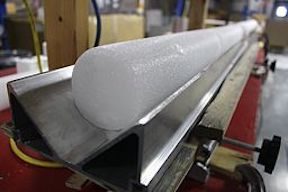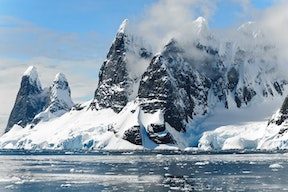Ice cores are a vital archive used in paleoclimatology — tracing temperature variability and atmospheric chemical composition. They are a build-up of snow (either in polar regions or high altitudes) occurring on annual cycles, resulting in distinct layers of ice which show seasonal variations (in the uncompacted surface material). Importantly, the ice layers trap air bubbles, precipitation in the form of snow and ash from volcanic eruptions (BAS, 2022).
Ice core records reach back 100 ka in Greenland and the oldest measurements in Antarctica date from the mid-Pleistocene (~1 Ma) (Higgins et al. 2015). Depending on accumulation and compaction measurements on these cores can be resolved to within a decade which represents orders of magnitude higher resolution than the other great paleoclimatological repository, sediment cores.
A key accomplishment of this record documents the glacial-interglacial cycles (Lüthi et al. 2008; Osman et al. 2021) connecting greenhouse gas (GHG) variations with the onset and termination of glacial events. In particular, it demonstrates that while the last 10 ky has seen a relatively stable climate, previous interglacials were characterized by extreme temperature shifts far exceeding variations that are seen today (Johnsen et al. 2001). This has been important in providing context to the increase in anthropogenic GHG composition of today’s atmosphere.

The air bubbles trapped in the ice core are direct samples of ancient atmospheric gas composition (e.g. methane, carbon dioxide). The chemical composition of snow layers provides detailed information on temperature (including seasonal temperature variations and extreme climate change events) through the analysis of stable oxygen isotopes as well as changes in atmospheric conditions (particularly in combination with dust inclusion analysis) (e.g. Parrenin et al. 2013; Petit et al. 1999; Shakun et al. 2012; Marcott et al. 2014).
Ash from volcanic eruptions can become trapped in ice layers when large eruptions occur, spreading sulfuric acid (H₂SO₄) across the globe; the concentration of H₂SO₄ can provide an estimate of the eruption size while the general ash composition supplies evidence of volcano origin. Finally, atmospheric dust and other aeolian deposits found within ice core layers can be analyzed using strontium, neodymium and hafnium isotopes to identify source origin.

Such first order access to paleo-conditions is extremely rare, and it is from such that the field can ground-truth the indirect geochemical proxies that it must rely on for those periods without a co-occurring ice core record. As such, cross comparison of ice cores with other paleoclimate records (e.g. lacustrine/marine sediments/carbonates, tree-rings, cave deposits) is common. This allows for the investigation of regional timing and/or differences in local impacts. Such other records are typically dated using radiocarbon (14C) dating. In order to explore the timing of such events and synchronize events within ice core records with different archives, the ice cores must be dated using 14C dating or calibrated using another radiogenic dating methodology (e.g. 10Be).
As the synchronization of 14C and 10Be can be challenging (e.g. required sophisticated statistical approaches; Adolphi and Muscheler, 2016), significant effort has been made to develop methodologies of measuring 14C within ice cores (e.g. Fang et al. 2021). For example, 14C ages can be deduced in ice cores by measuring the water-insoluble organic carbon fraction or the dissolved organic fraction within the ice — particles that are integrated through time from atmospheric deposition. These organic carbon samples typically originate from the terrestrial biosphere and thus should be in equilibrium with the atmosphere.
Miami-based Beta Analytic provides radiocarbon dating of the organic carbon fraction of water (melted ice) providing the sample meets a minimum DOC concentration of 5.0 mg C/L (5.0 ppm). The stable carbon isotope ratio (δ13C) is included as part of the service, which can provide evidence of carbon cycle changes through time. Other isotopic measurements (δ18O, δ2H) can also be requested.
How much does carbon dating cost?
References:
Photo Credits:
Ice core – Eli Duke, CC BY-SA 2.0, via Wikimedia Commons
Glacier – Pexels/Pixabay

Subscribe to our mailing list to receive news of upcoming webinars and other industry updates.
Free Webinars Available On Demand:
This entry was posted on Wednesday, August 30th, 2023 and is filed under Beta Analytic Updates .